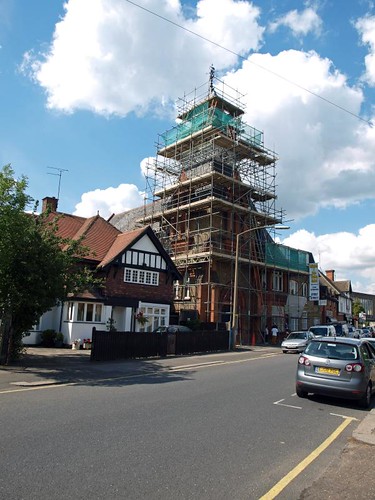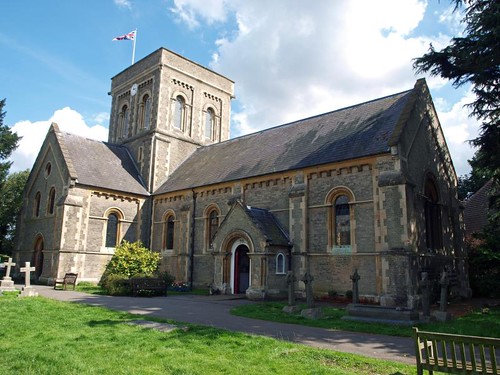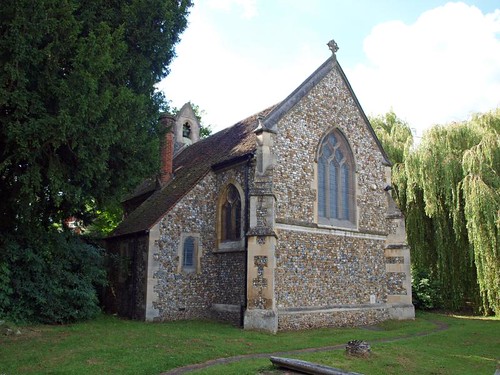St Mary is Victorian and was under scaffolding and was probably locked but as I couldn't find anywhere to park, and wasn't very interested in another new build interior, I can't be sure.
St Nicholas is the most interesting of these three Victorian buildings and the interior sounds even more so - so obviously it's padlocked shut and no keyholder is mentioned.
ST JOHN THE BAPTIST, Church Lane. 1846 by Sydney Smirke. It is a surprise here to find him using the fashionable Neo-Norman. Yellow brick is the material, which does not help the Norman spirit. The plan is without aisles, but with transept, crossing, and crossing tower. The vaults used throughout are no doubt plaster. Enlarged 1877.
ST MARY THE VIRGIN, High Street. 1871-2 by T. H. Watson. This is the church in the present shopping centre of Loughton. St John the Baptist and St Nicholas are both in more marginal (and leafier) positions. Nave with bellcote at the E end and apse. Yellow and red brick. Nave and aisles, the arcades with circular piers ending in capitals of the most riotous naturalism, a quite exceptionally large variety of native flowers and leaves; for the High Victorian fan very useful to study. The clerestory has trefoil windows outside, but the rear-arches are of two low 7 lights with a separate circle above.
ST NICHOLAS, Rectory Lane. The old village church of Loughton, or rather near the site of the old village church. For the present church was entirely rebuilt in 1877. It is very small, with nave and bellcote and a short chancel. - STAINED GLASS. Two kneeling figures of c. 1500 in N and S windows. - BRASSES of 1541, 1558, 1594, and 1637. E of the church a very Gothic churchyard monument of 1860, in the shape of a shrine with a steep-pitched roof.
LOUGHTON. It is on the edge of Epping Forest, and it must for ever be proud of the Village Hampden who saved the forest from being stolen from the people. It has lost its old church, of which but a stone or two and a fragment of the churchyard wall remain, but on its site a church was built last century "in memory of all who lie in the churchyard."
In the new church are a few things from the old one: a little glass of two kneeling figures older than the Reformation, a charming little cupboard of the 16th century with a tiny painting of the Annunciation three inches deep, and four brasses with 26 people on them. Three of the brasses are 16th century; George Stonard in armour with his wife, John Stonard with two wives, and William Nodes with eight sons whose names are all given. The other brass is 17th century and shows Abel Guilliams kneeling with his wife and their ten children. In one of the windows is a charming figure of St Winifred in memory of a lady of Loughton who died in Samoa.
It was Thomas Willingale who made Loughton famous last century by his brave fight for the rights of the people to the freedom of Epping Forest. He was a poor villager who made a scanty living by gathering wood and grazing animals there. But in the middle of last century, when the lands of the people were being everywhere enclosed, even the Crown rights of Epping Forest were sold and the villagers were robbed of their rights. Willingale was then an old man, but the thought of this injustice was too much for him, and he flung himself into the battle for the preservation of a beauty spot and of customs as old as history. The Corporation of London came to his assistance in the end, and after 15 years of battles in Parliament and the courts a Royal Commission found that the old man was right and that the enclosures were illegal.
A vast sum of money was spent before Epping Forest was declared free for the people again, but in the end Queen Victoria went down and opened 6800 acres as a public place for ever.
In the new church are a few things from the old one: a little glass of two kneeling figures older than the Reformation, a charming little cupboard of the 16th century with a tiny painting of the Annunciation three inches deep, and four brasses with 26 people on them. Three of the brasses are 16th century; George Stonard in armour with his wife, John Stonard with two wives, and William Nodes with eight sons whose names are all given. The other brass is 17th century and shows Abel Guilliams kneeling with his wife and their ten children. In one of the windows is a charming figure of St Winifred in memory of a lady of Loughton who died in Samoa.
It was Thomas Willingale who made Loughton famous last century by his brave fight for the rights of the people to the freedom of Epping Forest. He was a poor villager who made a scanty living by gathering wood and grazing animals there. But in the middle of last century, when the lands of the people were being everywhere enclosed, even the Crown rights of Epping Forest were sold and the villagers were robbed of their rights. Willingale was then an old man, but the thought of this injustice was too much for him, and he flung himself into the battle for the preservation of a beauty spot and of customs as old as history. The Corporation of London came to his assistance in the end, and after 15 years of battles in Parliament and the courts a Royal Commission found that the old man was right and that the enclosures were illegal.
A vast sum of money was spent before Epping Forest was declared free for the people again, but in the end Queen Victoria went down and opened 6800 acres as a public place for ever.




No comments:
Post a Comment